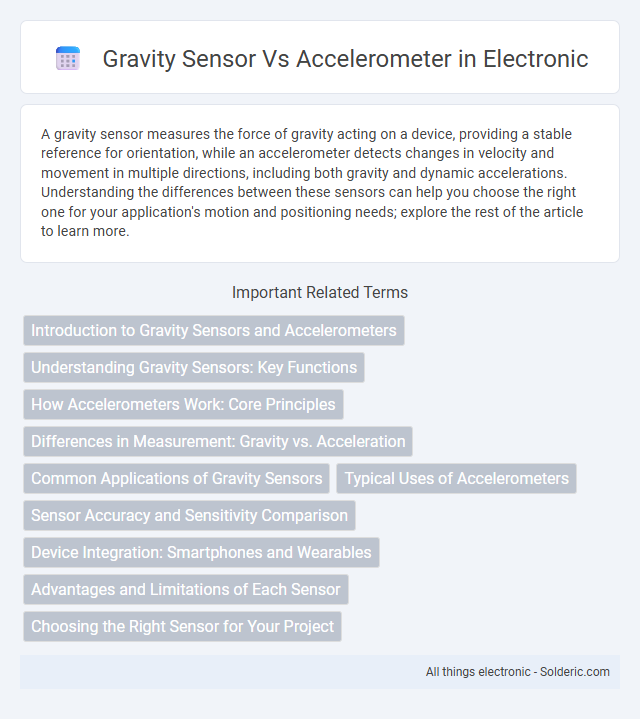A gravity sensor measures the force of gravity acting on a device, providing a stable reference for orientation, while an accelerometer detects changes in velocity and movement in multiple directions, including both gravity and dynamic accelerations. Understanding the differences between these sensors can help you choose the right one for your application's motion and positioning needs; explore the rest of the article to learn more.
Comparison Table
| Aspect | Gravity Sensor | Accelerometer |
|---|---|---|
| Function | Measures the force of gravity (static acceleration) | Measures total acceleration including gravity and movement (dynamic acceleration) |
| Output | Gravity vector, typically in m/s2 | Acceleration vector including all forces, in m/s2 |
| Usage | Detect device orientation, tilt, and gravity-based positioning | Detect movement, vibration, and device motion |
| Sensor Type | Software or fused sensor using accelerometer and gyroscope data | Hardware sensor based on MEMS technology |
| Data Filtering | Filtered to isolate gravity component | Raw data including gravity and dynamic movements |
| Common Applications | Screen orientation, gaming tilt control, augmented reality | Step counters, motion detection, fall detection |
Introduction to Gravity Sensors and Accelerometers
Gravity sensors measure the static force of Earth's gravity to determine device orientation and tilt, crucial for applications like level detection and augmented reality. Accelerometers detect dynamic acceleration forces, including movement and vibration, by measuring changes in velocity across different axes. Combining data from both sensors enhances motion tracking accuracy in smartphones, wearables, and robotics.
Understanding Gravity Sensors: Key Functions
Gravity sensors measure the force of gravity acting on a device, providing a constant reference vector that helps determine orientation relative to the Earth's surface. Unlike accelerometers, which detect all acceleration forces including movement and vibration, gravity sensors isolate the static gravitational pull for more accurate tilt and posture detection. Your device relies on gravity sensors for smoother motion tracking and orientation-based applications such as navigation and gaming.
How Accelerometers Work: Core Principles
Accelerometers measure acceleration forces by detecting changes in capacitance or piezoelectric effect caused by the movement of a proof mass inside the sensor. Gravity sensors utilize accelerometers to isolate the gravitational acceleration component from other motion-induced accelerations, relying on this core principle to determine spatial orientation. Your device uses accelerometers to accurately capture both dynamic acceleration and static gravitational forces for precise motion and tilt sensing.
Differences in Measurement: Gravity vs. Acceleration
Gravity sensors measure the static force exerted by Earth's gravitational pull, providing a continuous vector that indicates the direction and magnitude of gravity relative to the device. Accelerometers detect dynamic acceleration forces, including movement, vibration, and impact, capturing changes in velocity along multiple axes. Your choice depends on whether you need to isolate gravity's constant force or track variable motion and acceleration for applications like navigation, gaming, or fitness tracking.
Common Applications of Gravity Sensors
Gravity sensors are widely used in smartphone orientation detection, enabling your device to adjust screen rotation precisely. They play a critical role in fitness trackers by measuring posture and balance through static gravitational force. Automotive systems also rely on gravity sensors for stability control and advanced driver-assistance features, enhancing safety and performance.
Typical Uses of Accelerometers
Accelerometers are commonly used in smartphones and wearable devices to detect screen orientation, steps, and motion gestures. In automotive systems, they provide critical data for airbag deployment and stability control. These sensors also play a vital role in industrial machinery for vibration monitoring and impact detection.
Sensor Accuracy and Sensitivity Comparison
Gravity sensors provide precise measurements of the Earth's gravitational pull by filtering out linear acceleration, resulting in higher accuracy for detecting orientation and tilt compared to accelerometers. Accelerometers measure both static gravity and dynamic acceleration forces, offering greater sensitivity to motion but often less accuracy in isolating gravity alone. Your choice depends on whether you need precise gravity detection or responsiveness to overall movement dynamics.
Device Integration: Smartphones and Wearables
Gravity sensors in smartphones and wearables specifically measure the force of gravity, providing accurate orientation data for user interface adjustments and activity tracking. Accelerometers detect overall acceleration forces, including motion and vibration, enabling features like step counting and gesture recognition. Combining both sensors enhances device integration by delivering precise motion detection and orientation awareness, improving user experience and functionality.
Advantages and Limitations of Each Sensor
Gravity sensors provide precise measurement of the earth's gravitational force, enabling accurate detection of orientation and tilt without interference from device movement, which makes them ideal for applications requiring stable reference data. Accelerometers offer dynamic motion detection by measuring acceleration forces from both gravity and device movement, making them suitable for activity tracking and vibration analysis but prone to noise in static orientation measurement. Your choice depends on whether you need consistent orientation data with gravity sensors or versatile motion detection capabilities with accelerometers.
Choosing the Right Sensor for Your Project
Selecting between a gravity sensor and an accelerometer depends on your project's precision requirements and application context. Gravity sensors provide accurate measurements of gravitational force, crucial for tilt detection and orientation applications, while accelerometers measure total acceleration including motion and vibration, suitable for dynamic motion tracking. Understanding the specific need for static orientation versus dynamic movement enables optimal sensor integration for enhanced performance and data accuracy.
gravity sensor vs accelerometer Infographic

 solderic.com
solderic.com